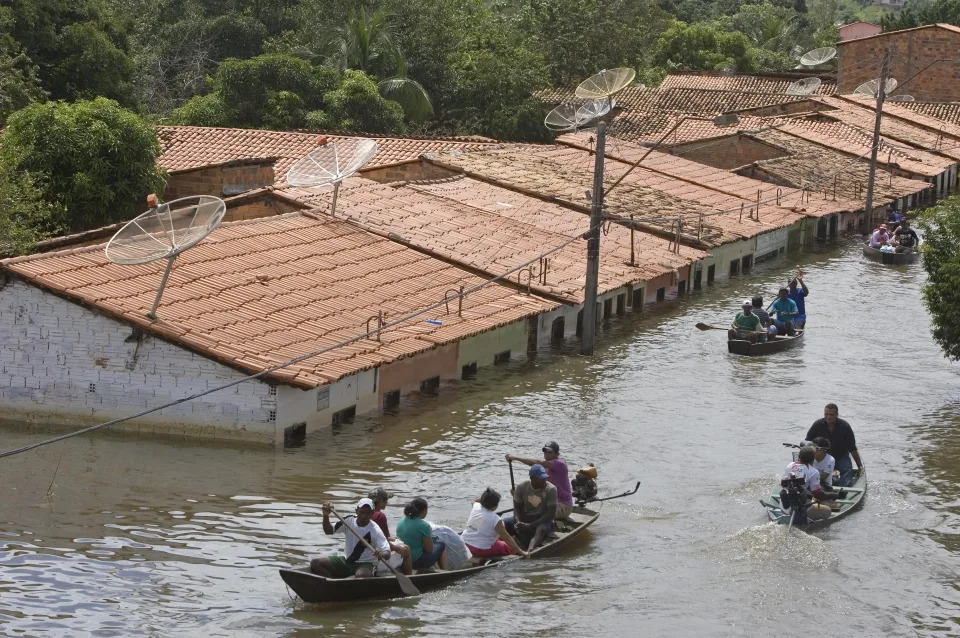
People travel by boat in a flooded street in Trizidela do Vale, state of Maranhao, Brazil, May 9, 2009. The intensity of extreme drought and rainfall has “sharply” increased over the past 20 years, according to a study published Monday, March 13, 2023, in the journal Nature Water.
ISABELLA O'MALLEY
Mon, March 13, 2023
The intensity of extreme drought and rainfall has “sharply” increased over the past 20 years, according to a study published Monday in the journal Nature Water. These aren’t merely tough weather events, they are leading to extremes such as crop failure, infrastructure damage, even humanitarian crises and conflict.
The big picture on water comes from data from a pair of satellites known as GRACE, or Gravity Recovery and Climate Experiment, that were used to measure changes in Earth’s water storage — the sum of all the water on and in the land, including groundwater, surface water, ice, and snow.
“It’s incredible that we can now monitor the pulse of continental water from outer space,” said Park Williams, a bioclimatologist at the University of California, Los Angeles who was not involved with the study.
“I have a feeling when future generations look back and try to determine when humanity really began understanding the planet as a whole, this will be one of the studies highlighted," he said.
The researchers say the data confirms that both frequency and intensity of rainfall and droughts are increasing due to burning fossil fuels and other human activity that releases greenhouse gases.
“I was surprised to see how well correlated the global intensity was with global mean temperatures,” said Matthew Rodell, study author and deputy director of Earth sciences for hydrosphere, biosphere, and geophysics at NASA Goddard Space Flight Center.
The strong link between these climate extremes and rising global average temperatures means continued global warming will mean more drought and rainstorms that are worse by many measures — more frequent, more severe, longer and larger.
Researchers looked at 1,056 events from 2002-2021 using a novel algorithm that identifies where the land is much wetter or drier than normal.
That showed the most extreme rains keep happening in sub-Saharan Africa, at least through December 2021, the end of the data. The rainfall extremes also took place in central and eastern North America from 2018-2021, and Australia during 2011-2012.
The most intense droughts were a record-breaking one in northeastern South America from 2015-2016; an event in the Cerrado region of Brazil that began in 2019 and continues; and the ongoing drought in the American Southwest that has caused dangerously low water levels in two of the biggest U.S. reservoirs, Lake Mead and Lake Powell. Those remain low despite heavy rains this year.
Drought events outnumbered heavy rain events by 10%. Their geographic extents and how long they lasted were similar.
A warmer atmosphere increases the rate at which water evaporates during dry periods. It also holds more water vapor, which fuels heavy rainfall events.
The study noted that infrastructure like airports and sewage treatment plants that were designed to withstand once-in-a-100-year events are becoming more challenged as these extremes happen more often and with more intensity.
“Looking forward into the future, in terms of managing water resources and flood control, we should be anticipating that the wetter extremes will be wetter and the dry extremes will get drier,” said Richard Seager, a climate scientist at the Lamont Doherty Earth Observatory at Columbia University, who was not involved with the study.
Seager said it's a mistake to assume that future wet and dry extremes can be managed the same as in the past because “everything’s going to get amplified on both ends of the dry-wet spectrum.”
According to the U.S. National Integrated Drought Information System, 20% of the annual economic losses from extreme weather events in the U.S. are from floods and droughts.
A drastic swing between extreme drought and unprecedented flooding, dubbed “weather whiplash,” is becoming common in some regions.
Water stress is expected to significantly affect poor, disenfranchised communities as well as ecosystems that have been underfunded and exploited.
For example, the United Nations has said that Somalia is experiencing its longest and most severe drought, an event that has caused the deaths of millions of livestock and widespread hunger. Venezuela, a country that has faced years of political and economic crises, resorted to nationwide power cuts during April 2016 as a result of the drought conditions affecting water levels of the Guri Dam.
As for solutions, using floodwaters to replenish depleted aquifers and improving the health of agricultural soil so it can absorb water better and store more carbon are just a few methods that could improve water resiliency in a warming world, the study says.
——
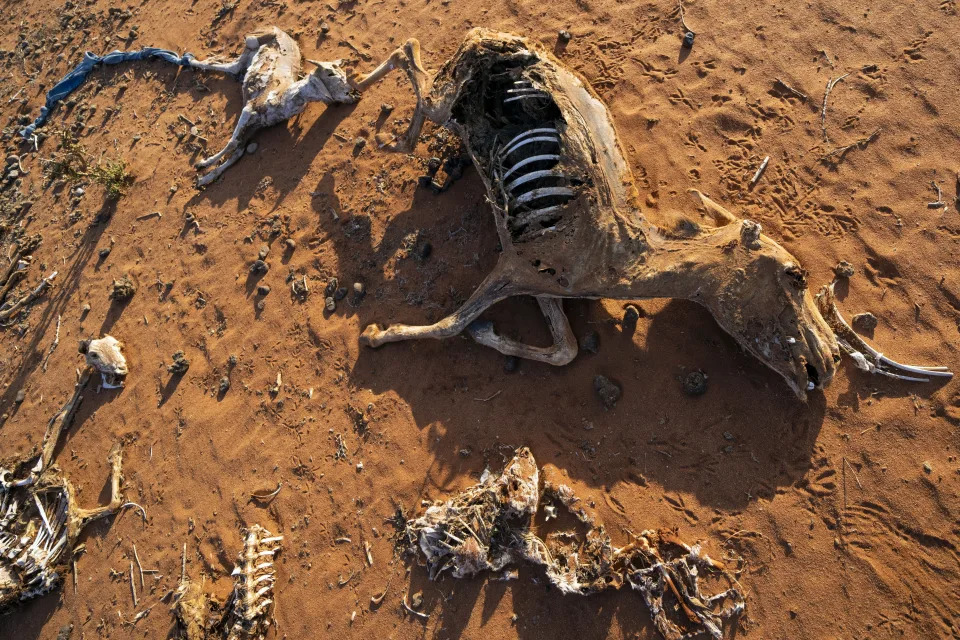
The remains of dead livestock and a donkey are scattered at a camp for displaced people on the outskirts of Dollow, Somalia, Sept. 21, 2022. The intensity of extreme drought and rainfall has “sharply” increased over the past 20 years, according to a study published Monday, March 13, 2023, in the journal Nature Water.
(AP Photo/Jerome Delay, File)
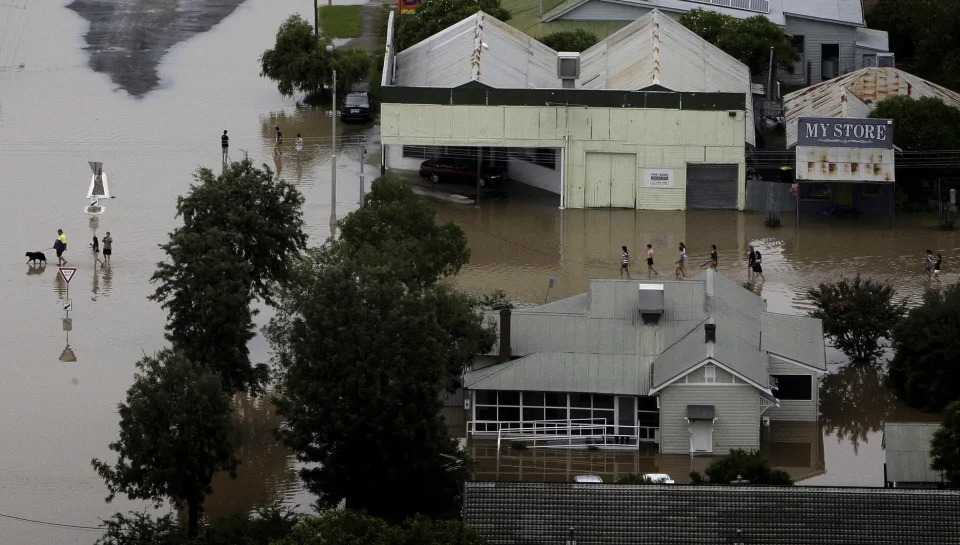
People wade through flood waters in the town of Moree, Northern New South Wales, Australia, Feb. 3, 2012. The intensity of extreme drought and rainfall has “sharply” increased over the past 20 years, according to a study published Monday, March 13, 2023, in the journal Nature Water. (AP Photo/Brad Hunter, Pool, File)
Ad•HistoryA2Z
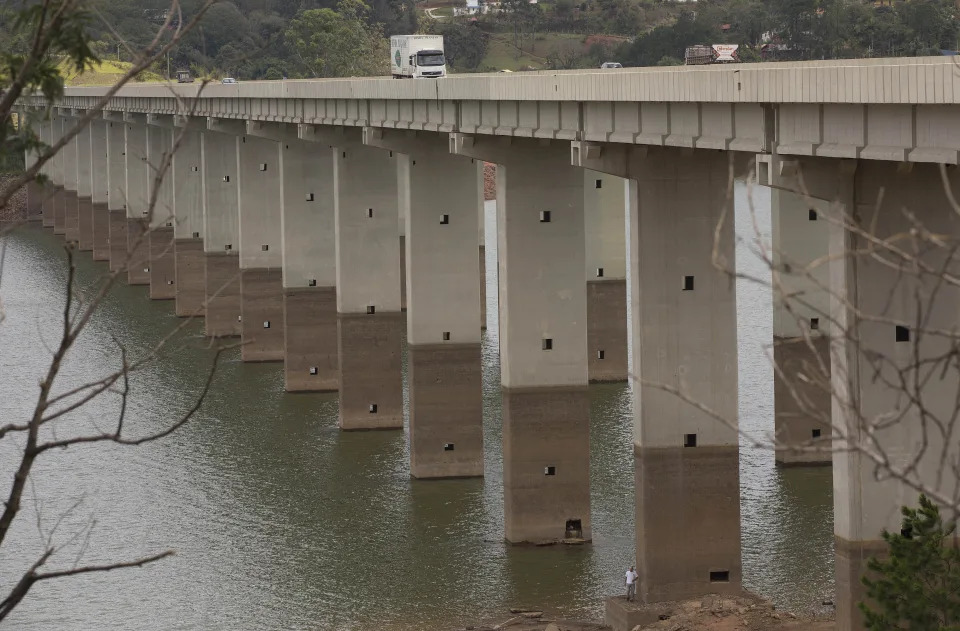
A bridge's columns are marked by the previous water line over the Atibainha reservoir, part of the Cantareira System that provides water to the Sao Paulo metropolitan area, in Nazare Paulista, Brazil, on Jan. 29, 2015. The intensity of extreme drought and rainfall has “sharply” increased over the past 20 years, according to a study published Monday, March 13, 2023, in the journal Nature Water. (AP Photo/Andre Penner, File)
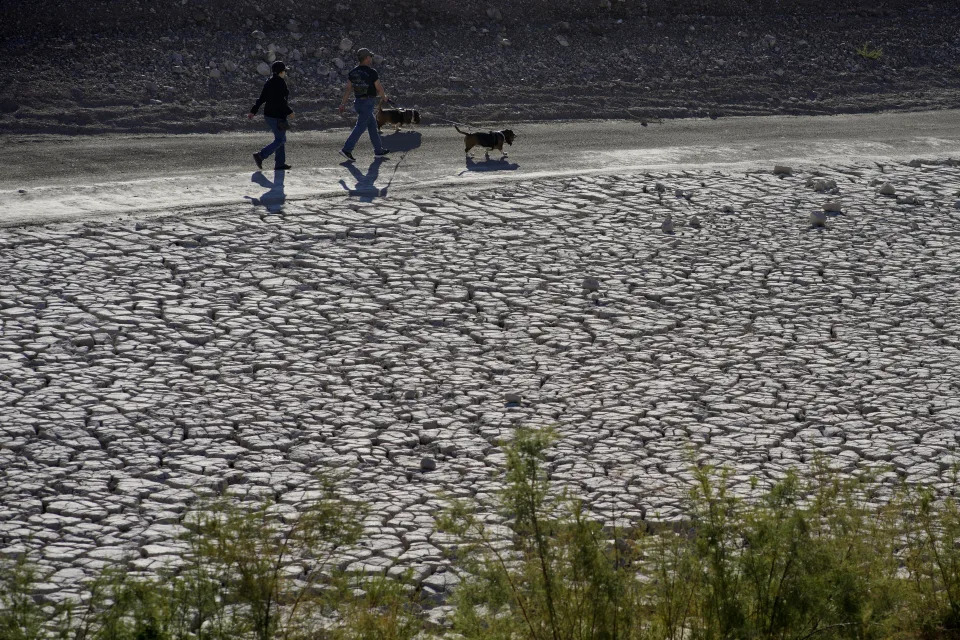
People walk by cracked earth in an area once under the water of Lake Mead at the Lake Mead National Recreation Area, Jan. 27, 2023, near Boulder City, Nev. The intensity of extreme drought and rainfall has “sharply” increased over the past 20 years, according to a study published Monday, March 13, 2023, in the journal Nature Water.

People wade through flood waters in the town of Moree, Northern New South Wales, Australia, Feb. 3, 2012. The intensity of extreme drought and rainfall has “sharply” increased over the past 20 years, according to a study published Monday, March 13, 2023, in the journal Nature Water. (AP Photo/Brad Hunter, Pool, File)
Ad•HistoryA2Z

A bridge's columns are marked by the previous water line over the Atibainha reservoir, part of the Cantareira System that provides water to the Sao Paulo metropolitan area, in Nazare Paulista, Brazil, on Jan. 29, 2015. The intensity of extreme drought and rainfall has “sharply” increased over the past 20 years, according to a study published Monday, March 13, 2023, in the journal Nature Water. (AP Photo/Andre Penner, File)

People walk by cracked earth in an area once under the water of Lake Mead at the Lake Mead National Recreation Area, Jan. 27, 2023, near Boulder City, Nev. The intensity of extreme drought and rainfall has “sharply” increased over the past 20 years, according to a study published Monday, March 13, 2023, in the journal Nature Water.
(AP Photo/John Locher, File)
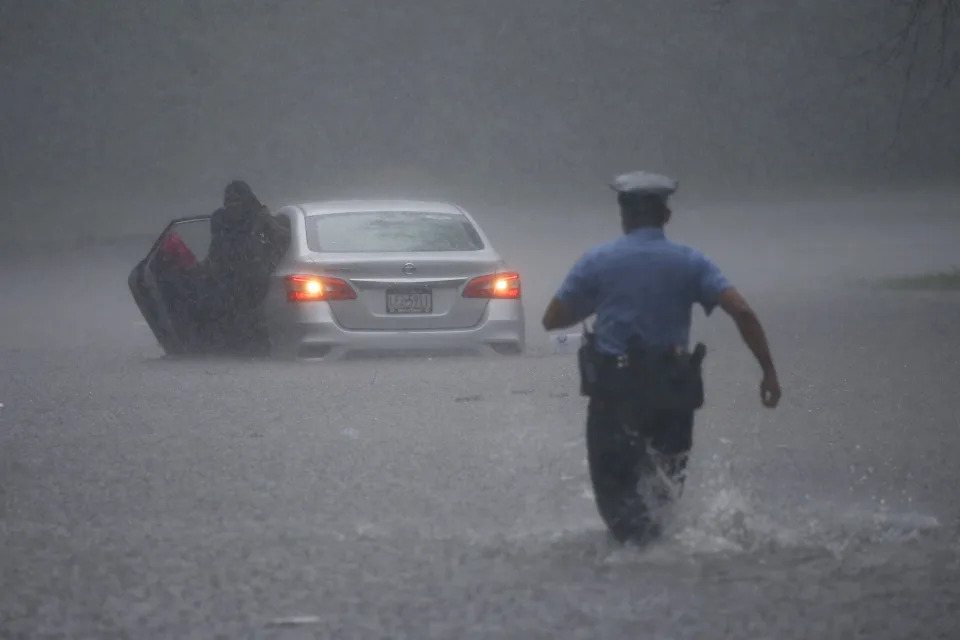
A Philadelphia police officer rushes to help a stranded motorist during Tropical Storm Isaias, Aug. 4, 2020, in Philadelphia. The intensity of extreme drought and rainfall has “sharply” increased over the past 20 years, according to a study published Monday, March 13, 2023, in the journal Nature Water. (AP Photo/Matt Slocum, File)
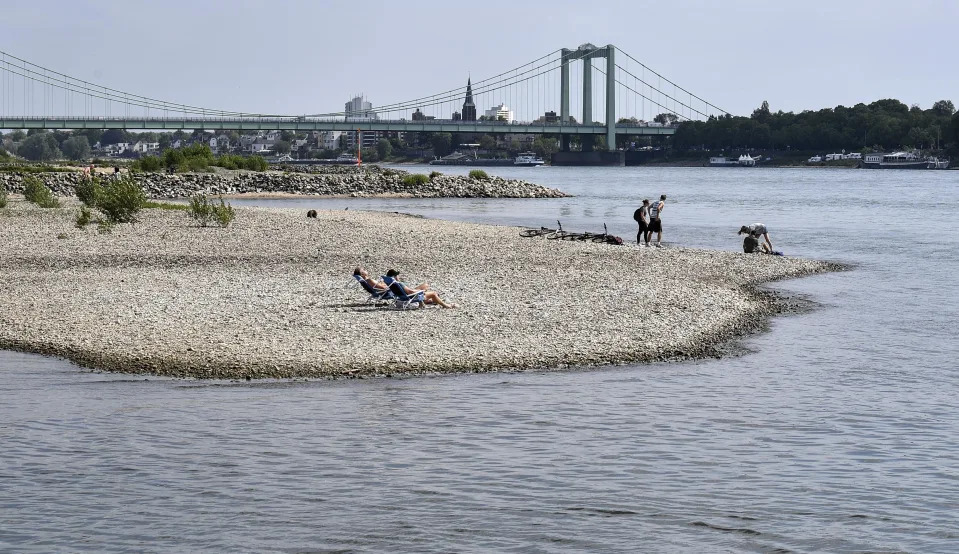
People enjoy the sunny weather on dry river banks of Germany's most important river Rhine in Cologne, Germany, after a long time of drought, April 27, 2020. The intensity of extreme drought and rainfall has “sharply” increased over the past 20 years, according to a study published Monday, March 13, 2023, in the journal Nature Water.

A Philadelphia police officer rushes to help a stranded motorist during Tropical Storm Isaias, Aug. 4, 2020, in Philadelphia. The intensity of extreme drought and rainfall has “sharply” increased over the past 20 years, according to a study published Monday, March 13, 2023, in the journal Nature Water. (AP Photo/Matt Slocum, File)

People enjoy the sunny weather on dry river banks of Germany's most important river Rhine in Cologne, Germany, after a long time of drought, April 27, 2020. The intensity of extreme drought and rainfall has “sharply” increased over the past 20 years, according to a study published Monday, March 13, 2023, in the journal Nature Water.
(AP Photo/Martin Meissner, File)
A warmer world causes extreme drought and rain. ‘Indisputable’ new research proves it.
Intense drought and heavy rainfall events have occurred more often in the last eight years than the previous decade, a new study finds.
By Kasha Patel
Updated March 13, 2023
Intense drought and heavy rainfall events have occurred more often in the last eight years than the previous decade, a new study finds.
By Kasha Patel
Updated March 13, 2023
Intense drought and heavy rainfall events occurred more often in the last eight years — the hottest years on record — than in the previous decade, according to a new study released in Nature Water on Monday. Warmer global temperatures are increasing the extent, duration, and severity of these extremes, the authors found, and are having more of an effect than natural climate patterns.
“As the world warms, we’re having more intense and more frequent wet and dry events around the world, which gives us a little insight into what’s going to happen in the future,” said Matthew Rodell, a hydrologist at NASA and co-author of the study. “This is an observation. It’s actual data.”
Rodell said researchers have expected to see more droughts and floods in a warmer world based on climate model predictions, but “it’s been really hard to prove.” This new analysis, which uses direct NASA satellite observations, provides “indisputable” evidence that warmer global temperatures are increasing such extreme events, Rodell said.
The team analyzed 1,056 extreme events from 2002 to 2021, using observations from NASA’s Gravity Recovery and Climate Experiment (GRACE) and GRACE Follow-On (GRACE-FO) satellites. The satellites detect subtle variations in Earth’s gravity field, which are used to measure water storage — including groundwater, soil moisture, snow, ice and surface waters — on land. Comparing current data to a longer-term average, the researchers can map anomalies and determine where water storage on land has increased or decreased. In this study, Rodell and NASA hydrologist Bailing Li used an algorithm that identified areas above or below average for a period of time by at least 16 percent.
While natural and recurring climate patterns, such as El Niño or La Niña, may have exacerbated some of these events, the team found that warmer global temperatures had a greater influence than other factors. Rodell said a correlation analysis of the extreme events found that no other factors were as “high as the correlation with the global mean temperature.”
The team found extreme dry and wet events have been increasing since 2002, but the most intense events have been occurring more frequently since 2015 — when Earth began its run of record-breaking warm years. An average of four extreme events occurred each year since 2015, compared to only three annual events over the previous 13 years.
The study adds to existing research, using rain gauge data, climate models and tree rings, on how a warmer atmosphere is affecting extreme wet and dry events, said climate scientist Daniel Swain, who was not involved in the study. Given the accumulation of evidence, he said it’s “probably not coincidental that the most extreme hydrologic events that you could observe in this record occurred during the warmest years of the record.”
“I think if this were just coming out of the blue and this is the only evidence we had that hydroclimate extremes were becoming greater in a warming climate, it wouldn’t be super strong evidence unto itself,” said Swain, a researcher at the University of California at Los Angeles. “But because it exists in the context of other research, I actually think it’s more interesting and more important.”
On average, the team found a wet or dry extreme event lasted about five to six months. About 70 percent lasted six months or less, and another 10 percent lasted a year or more. Globally, there were 10 percent more dry events than wet events. Wetter events tended to occur near the equator, while drier conditions occurred at the mid-latitudes.
Swain said the analysis provides almost direct measures of the amount of water on Earth’s surface at a given time and location, which is helpful because there is a “really incomplete rain observation network globally,” especially outside of wealthy nations.
The most intense event overall over the past two decades — dry or wet — was a wet event that engulfed all of central Africa, which began in 2019. Water levels at Lake Victoria rose by one meter and caused flooding in the surrounding region. It was three times as big as any other wet or dry event in their observations, Rodell said. “It’s just amazing how huge it was in terms of intensity,” he said.
The second most intense wet event occurred from 2018 to 2021 over much of central and eastern North America. During this time period, Rodell said parts of the United States were receiving a lot more rain and snow than normal. Aquifers, lakes and rivers were full and soil was generally moist. Some flooding occurred in the Midwest.
The most intense dry event observed was a short-lived but record-breaking drought in northeastern South America from 2015 to 2016, the study said. Three of the other most intense droughts have occurred in recent years as well, including drought in Brazil and the southwestern United States and recent drought across Europe.
Many of these extreme dry and wet events, including the flood in central Africa, drought in Brazil and the southwestern United States, are still ongoing in 2023.
The team did exclude some areas, such as central California and northern India, where people have pumped groundwater and depleted aquifers. Rodell said these depletions were caused more from direct human water management rather than meteorological drought.
“These findings not only verify model predictions, but also the ‘dry gets drier, wet gets wetter,’ hypothesis,” groundwater scientist Melissa Rohde wrote in a separate review article that appeared in Nature on Monday.
Seeing an increase in both dry and wet events may sound counterintuitive, but the physics are two sides of the same coin. During a dry event, the air is warmer and can drive more evaporation from the surface. During a wet event, a warmer atmosphere can hold more moisture (about 4 percent more for every degree Fahrenheit the atmosphere warms) and transport more moisture into an area.
Swain said that such projected increases in intense dry and wet events was largely a prediction but had not been confirmed in observations. Today, the evidence is strong.
“As the world warms, it’s fair to say that we may expect to see more frequent, more intense droughts and wet events,” said Rodell. “Here, we have the evidence that’s already happening.”

By Kasha Patel edits and reports on the weather, climate and environment for the Capital Weather Gang at The Washington Post. Before joining The Post, she covered Earth sciences and satellite research for NASA. Twitter
“As the world warms, we’re having more intense and more frequent wet and dry events around the world, which gives us a little insight into what’s going to happen in the future,” said Matthew Rodell, a hydrologist at NASA and co-author of the study. “This is an observation. It’s actual data.”
Rodell said researchers have expected to see more droughts and floods in a warmer world based on climate model predictions, but “it’s been really hard to prove.” This new analysis, which uses direct NASA satellite observations, provides “indisputable” evidence that warmer global temperatures are increasing such extreme events, Rodell said.
The team analyzed 1,056 extreme events from 2002 to 2021, using observations from NASA’s Gravity Recovery and Climate Experiment (GRACE) and GRACE Follow-On (GRACE-FO) satellites. The satellites detect subtle variations in Earth’s gravity field, which are used to measure water storage — including groundwater, soil moisture, snow, ice and surface waters — on land. Comparing current data to a longer-term average, the researchers can map anomalies and determine where water storage on land has increased or decreased. In this study, Rodell and NASA hydrologist Bailing Li used an algorithm that identified areas above or below average for a period of time by at least 16 percent.
While natural and recurring climate patterns, such as El Niño or La Niña, may have exacerbated some of these events, the team found that warmer global temperatures had a greater influence than other factors. Rodell said a correlation analysis of the extreme events found that no other factors were as “high as the correlation with the global mean temperature.”
The team found extreme dry and wet events have been increasing since 2002, but the most intense events have been occurring more frequently since 2015 — when Earth began its run of record-breaking warm years. An average of four extreme events occurred each year since 2015, compared to only three annual events over the previous 13 years.
The study adds to existing research, using rain gauge data, climate models and tree rings, on how a warmer atmosphere is affecting extreme wet and dry events, said climate scientist Daniel Swain, who was not involved in the study. Given the accumulation of evidence, he said it’s “probably not coincidental that the most extreme hydrologic events that you could observe in this record occurred during the warmest years of the record.”
“I think if this were just coming out of the blue and this is the only evidence we had that hydroclimate extremes were becoming greater in a warming climate, it wouldn’t be super strong evidence unto itself,” said Swain, a researcher at the University of California at Los Angeles. “But because it exists in the context of other research, I actually think it’s more interesting and more important.”
On average, the team found a wet or dry extreme event lasted about five to six months. About 70 percent lasted six months or less, and another 10 percent lasted a year or more. Globally, there were 10 percent more dry events than wet events. Wetter events tended to occur near the equator, while drier conditions occurred at the mid-latitudes.
Swain said the analysis provides almost direct measures of the amount of water on Earth’s surface at a given time and location, which is helpful because there is a “really incomplete rain observation network globally,” especially outside of wealthy nations.
The most intense event overall over the past two decades — dry or wet — was a wet event that engulfed all of central Africa, which began in 2019. Water levels at Lake Victoria rose by one meter and caused flooding in the surrounding region. It was three times as big as any other wet or dry event in their observations, Rodell said. “It’s just amazing how huge it was in terms of intensity,” he said.
The second most intense wet event occurred from 2018 to 2021 over much of central and eastern North America. During this time period, Rodell said parts of the United States were receiving a lot more rain and snow than normal. Aquifers, lakes and rivers were full and soil was generally moist. Some flooding occurred in the Midwest.
The most intense dry event observed was a short-lived but record-breaking drought in northeastern South America from 2015 to 2016, the study said. Three of the other most intense droughts have occurred in recent years as well, including drought in Brazil and the southwestern United States and recent drought across Europe.
Many of these extreme dry and wet events, including the flood in central Africa, drought in Brazil and the southwestern United States, are still ongoing in 2023.
The team did exclude some areas, such as central California and northern India, where people have pumped groundwater and depleted aquifers. Rodell said these depletions were caused more from direct human water management rather than meteorological drought.
“These findings not only verify model predictions, but also the ‘dry gets drier, wet gets wetter,’ hypothesis,” groundwater scientist Melissa Rohde wrote in a separate review article that appeared in Nature on Monday.
Seeing an increase in both dry and wet events may sound counterintuitive, but the physics are two sides of the same coin. During a dry event, the air is warmer and can drive more evaporation from the surface. During a wet event, a warmer atmosphere can hold more moisture (about 4 percent more for every degree Fahrenheit the atmosphere warms) and transport more moisture into an area.
Swain said that such projected increases in intense dry and wet events was largely a prediction but had not been confirmed in observations. Today, the evidence is strong.
“As the world warms, it’s fair to say that we may expect to see more frequent, more intense droughts and wet events,” said Rodell. “Here, we have the evidence that’s already happening.”

By Kasha Patel edits and reports on the weather, climate and environment for the Capital Weather Gang at The Washington Post. Before joining The Post, she covered Earth sciences and satellite research for NASA. Twitter
No comments:
Post a Comment